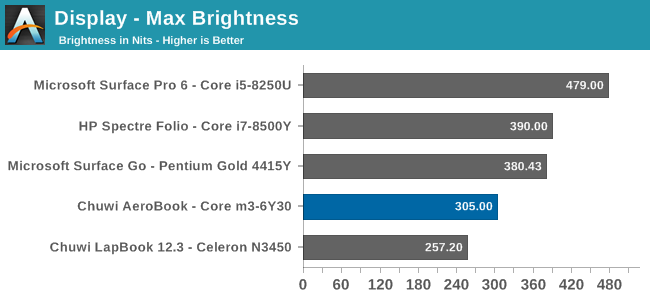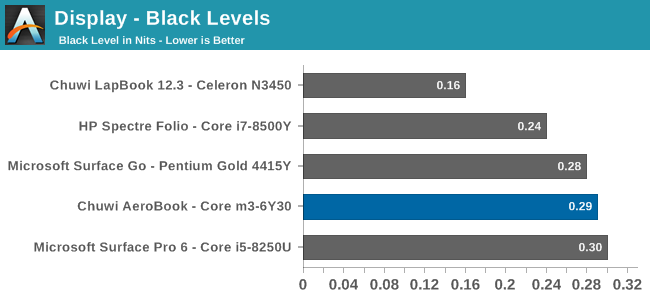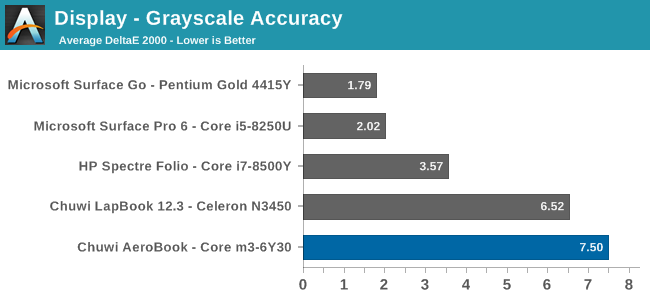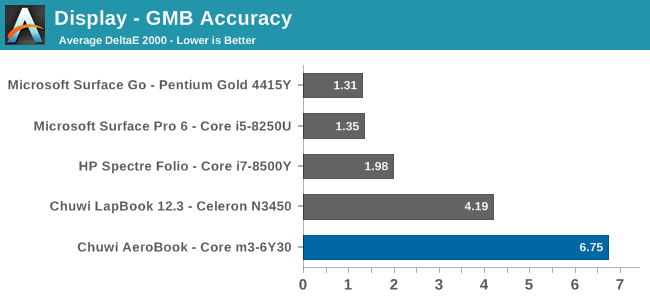The Chuwi AeroBook Review: One Small Step For Chuwi
by Brett Howse on June 21, 2019 8:00 AM ESTDisplay Analysis
One of the main reasons Chuwi has been easy to recommend at the low-end of the PC price scale is that they generally offer an IPS display, meaning great viewing angles, on many of their budget offerings. The Chuwi AeroBook continues this trend, although at the $499 price point, it’s less of a luxury and more of an expectation.
The 13.3-inch panel offers a 1920x1080 resolution, which is perfect for this size of notebook, and although a 3:2 offering would possibly be better, the panel choices are slimmer for the company trying to hit a price target when you move away from 16:9.
To see how the Chuwi AeroBook display performs, we tested it with Portrait Display’s CalMAN software with a custom workflow. For contrast and brightness readings, and X-Rite i1Display Pro colorimeter was used, and for color accuracy testing, the X-Rite i1Pro2 spectrophotometer gets the call.
Brightness and Contrast



At 305 nits peak brightness, the AeroBook is well under the average for laptops in this price range, but still reasonable bright. The black levels though are quite high, meaning the panel isn’t doing a great job of blocking the backlight when requested, and this means the contrast ratio is quite a bit lower than the other notebooks. At one point, 1000:1 was pretty good for an IPS display on a notebook, but improvements to panel design and aligned displays have moved the bar. So on this result, the display is OK but not great. For those that are curious, the display goes down to 19 nits at its lowest brightness, which is likely fine for a notebook, but quite a bit higher than many models which can offer sub-10 nit levels at 0% brightness.
Grayscale

We often discuss factory calibrated displays, like Microsoft does on the Surface lineup, and that most companies do not individually calibrate displays. But that doesn’t mean no effort is spent on calibration, since some work can be done at the batch level, and while it won’t lead to perfect results, it can still get a display in the range. Unfortunately, Chuwi doesn’t appear to do batch calibration either, which a horrendous result on the grayscale test. The red levels drop away dramatically, and the gamma level is not even close to the desired 2.2 level. As a budget device, this can be somewhat forgiven, but as Chuwi creeps up the price range with higher-priced options, it’s a negative against this device.
Gamut

Some devices in this price range skimp on the backlighting, meaning they can’t even do the full sRGB gamut. That is not the case here, with Chwui able to achieve a good result on sRGB, although the actual colors don’t quite hit the mark.
Saturation

Gamut tests the primary and secondary colors at 100% levels, but the saturation test checks the primary and secondary colors across the entire range, in 4-bit steps. On the primary colors, blue and red do a reasonable job hitting the correct axis, but green is quite a bit off. On the secondary colors, magenta is the one that is most affected. The end result isn’t great.
Gretag Macbeth

The Gretag Macbeth tests an assortment of colors rather than just focusing on the primary and secondary results, and includes the important skin tones. With no calibration at all, the AeroBook struggles here on almost every target.
Display Conclusion
As mentioned previously, offering an IPS display on Chuwi’s budget offerings makes them stand out against the competition which often still includes TN displays in those price ranges, but the AeroBook is no longer competing against $200 notebooks. The inclusion of an IPS display at the $500 range that this notebook hits is an expectation, so just offering one isn’t enough to make your product stand out. Unfortunately, Chuwi hasn’t put any effort into the display at all, other than ensuring the backlight can hit the entire sRGB gamut.















51 Comments
View All Comments
bubblyboo - Friday, June 21, 2019 - link
US-warranty vs no warranty is also pretty unfair.nandnandnand - Sunday, June 23, 2019 - link
Marlin and levizx are right. The sucker price is for suckers. There's something on sale in any given category at any moment. Go back a year or two and the main difference in a laptop will be the specific CPUs and GPUs, so judge price/perf accordingly.systemBuilder - Friday, July 19, 2019 - link
You can think of the "m" series of processors as "bringing the Atom Slowness to the Pentium Line of CPUs". In other words, when you spend 90% of your life thermally throttled because the device is stupid-thin AND stupid-light, you suffer a great deal... I prefer my Acer Chromebook c720 i3.Urthor - Saturday, June 22, 2019 - link
You have to understand the pressure that Intel puts on sellers with the prices of its CPUs to OEM'sSecondhand laptops have been FAR cheaper for a LOT longer because ultimately Intel's control of the key part stops them discounting.
mkozakewich - Friday, June 21, 2019 - link
Chuwi are a cheap manufacturer that have been known to ship cheap parts that fail, and they won't respond to warranty requests unless you can post a video to YouTube (seriously, what) showing some kind of physical damage.yeeeeman - Friday, June 21, 2019 - link
For 250$, maybe, but for 500...no wayabufrejoval - Friday, June 21, 2019 - link
I got the Lapbook 12.3 after the review here.The main attraction was the high-resolution (3k) screen and totally silent operation for e-books and surfing. And while my first unit had a defective space-bar and completely unusable touchpad (way too sensitive), the second one was rather better with both, and delivered on the performance and usability criteria.
I moved Windows 10 immediately to a 128GB M.2 SSD and then put a Ubuntu 18.04 on the eMMC, mostly because I needed a little more space anyway and to avoid slowing the machine via the storage.
The disappointment came when I unpacked the ChuWi in the hotel after a flight and found it all bent out of shape from a battery that had gassed out, because a replacement battery cannot be bought from anyone or anywhere: ChuWi simply does not sell spare parts.
It’s easy enough to replace, a couple of screws and unplugging a connector, but without a spare part, it’s life is essentially ended before a year is full.
After a bit of howling and screaming they did offer me to send it to HongKong for a free replacement, and I am torn between using it just on external power or actually see if it gets back fixed.
I’m not sure I can attribute the battery failure to a quality defect on their side, though.
It’s the second time the very same thing happened to me and the other one was a Gigabyte mobile workstation at 10x the price (no issue with the spare parts there).
I believe the fault actually lies with Windows.
When I hibernate a notebook, I expect it to stay powered off until I power it up again. But Windows these days has so much AI, it knows better and seems to wake up hibernated (not just suspended) machines for things like regular reports to Redmont.
Since some of my machines are configured to actually boot Ubuntu, CentOS or Fedora by default, that is especially useless, because the Windows induced wakeup has them boot an OS that didn’t even ask for that.
In the confines of rucksack in an overhead locker then, these machines can easily overheat and cook the batteries until they’re dead.
I have tried very hard to find a recipe to keep these wakeups from happening. I really do like the ability to keep documents and VMs open (and hibernated on SSD), while I travel.
So far the only way to avoid these wakeups, seems to be removing the power supply before hibernating the machines: At that point “hibernate” seems to be actually understood by Microsoft as meaning “don’t wake automagically so you don’t fry batteries by accident in an airplane”.
I have started using that approach on commutes, but for longer trips, I do shut down those laptops, because the risk of unwarranted wakeups is too high.
So there you have it: ChuWis don’t disappoint as hardware per se, but spare parts or service are not included at this price.
olafgarten - Friday, June 21, 2019 - link
Windows doesn't wake hibernated laptops unless some hardware connected to it issues a wakeup signal. You either accidentally hit the on button or you have a faulty keyboard wakeup key.Also if you are using Ubuntu as the main OS, you are probably booting into Grub and so Windows has no control over the wakeup.
abufrejoval - Friday, June 21, 2019 - link
And so would I have sworn, perhaps not on my life, but at least a case of beer...I was far more inclined to blame the flying or even the security scanners at the airport.
Yet major problems there would be hard to hide...
And then I got a Lenovo S730 ultrabook to replace it and observed it for days.
Hibernated it (hybrid disabled) and was very surprised to watch it power up and boot whatever happend to be configured as primary in the BIOS, ... and that changed between Windows 10 1903 and Fedora 30, depending on what was more frequently used.
Mind you, I disconnected all external devices, nothing and nobody touching it, the power button requires quite a bit of force to exercise, but within half an hour to a full one it would power on again.
Now, I am pretty sure, that nobody in my network sends magic packets or patterns, and in any case I disabled that too, but no change. There are dozens of jobs scheduled in Windows and I deleted quite a few of those, mostly the "calling home" type. Also stopped and disabled the "user experience service" etc.
But so far the only thing that changed the behavior was to change the unplugging and the hibernate sequence: With the power plugged in at hibernate, Windows seems to assume it's ok to run scheduled jobs. Without external power, "hibernate" is "hibernate".
And these days, when you say "shut down" on Windows, you have to uncheck a hidden option in Windows to actually *make* it shut-down. Otherwise it will be 'smart' enough to assume that restarting Windows more quickly is more important and interpret "shutdown" as suspend-with-fast-restart...
And I have seen similar behavior in desktops that were *suspended* to RAM, with all magic packets and PS/2 as well as USB events disabled in BIOS to cause power up.
On those systems, massive amounts of RAM and SATA SSDs made hibernation less attractive and standby seemed a good compromise...
Here on the Lenovo RAM is stuck as 16GB and the NVMe will restore RAM at 3GB/s...
But "wakeup2die" isn't really attractive.
Perhaps we could get a little more end-user data on this?
Mil0 - Sunday, June 23, 2019 - link
I've seen this behavior as well, using MSI/Acer laptops, so it's not limited to some manufacturers.Thanks for the no-power-when-hibernating trick, I'll use that from now on.
It's a bit silly that there is no thermal protection on the battery - should be a pretty easy/cheap fix.